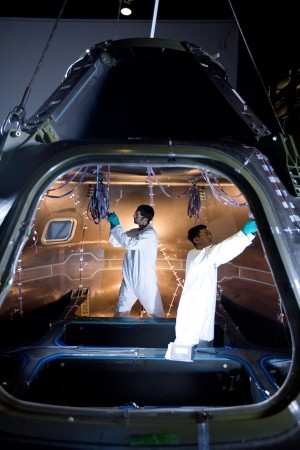Fri, Oct 16, 2009
A Crew Module Structure Made Of Composite Materials
 Alliant Techsystems said Thursday it has delivered a
technological first to NASA: a full-scale, crew module structure
made of composite materials. The Composite Crew Module (CCM) is a
unique capsule design that has the potential to reduce the overall
weight of future manned launch vehicles.
Alliant Techsystems said Thursday it has delivered a
technological first to NASA: a full-scale, crew module structure
made of composite materials. The Composite Crew Module (CCM) is a
unique capsule design that has the potential to reduce the overall
weight of future manned launch vehicles.
Composite structures reduce launch costs through weight savings
and are presently used on a variety of space launch vehicles and
aerospace structures. However, the CCM is unique in that it was
specifically designed and built to resemble a space capsule.
Full-scale structural testing will be performed at NASA's Langley
Research Center to determine the strength and viability of the
composite structure. During the destructive testing, the CCM will
be placed under load conditions similar to those observed during
launch, on-orbit, landing, and abort scenarios.
Led by the NASA Engineering and Safety Center (NESC), ATK was
part of a team of NASA and industry experts who designed and
fabricated the CCM to demonstrate how composite materials could be
used to develop a pressurized space capsule. ATK is a major
composite manufacturer and supplier for modern military and
commercial aircraft, and space launch vehicles. ATK provided
composites design, analysis, manufacturing and assembly expertise
for the CCM program.

"ATK has decades of experience in building composite structures
for launch vehicles, military aircraft, and most recently
commercial aircraft such as the Airbus A350," Jack Cronin,
President, ATK Mission Systems. "We have applied our innovative
engineering and manufacturing capabilities to help the CCM team
build a cutting-edge, composite space structure. We demonstrated
our ability to perform, partner and deliver an advanced composite
structure that's never been built for NASA."
Fabricated and assembled at ATK's Iuka, Miss. facility, the CCM
combines some of the most advanced composite manufacturing
technologies in use today. Constructed in two primary sections, the
upper and lower shells are joined together with a splice joint and
cured using out-of-autoclave technology. The bonding of the
composite assemblies and integration of metal hardware were
achieved by combining existing technology and ATK's innovative
manufacturing processes.
More News
Aero Linx: Florida Antique Biplane Association "Biplanes.....outrageous fun since 1903." That quote really defines what the Florida Antique Biplane Association (FABA) is all about.>[...]
Beyond Visual Line Of Sight (BVLOS) The operation of a UAS beyond the visual capability of the flight crew members (i.e., remote pilot in command [RPIC], the person manipulating th>[...]
Also: ForeFlight Upgrades, Cicare USA, Vittorazi Engines, EarthX We have a number of late-breaking news highlights from the 2024 Innovation Preview... which was PACKED with real ne>[...]
“For Montaer Aircraft it is a very prudent move to incorporate such reliable institution as Ocala Aviation, with the background of decades in training experience and aviation>[...]
Maximum Authorized Altitude A published altitude representing the maximum usable altitude or flight level for an airspace structure or route segment. It is the highest altitude on >[...]
 ANN's Daily Aero-Linx (04.13.24)
ANN's Daily Aero-Linx (04.13.24) ANN's Daily Aero-Term (04.13.24): Beyond Visual Line Of Sight (BVLOS)
ANN's Daily Aero-Term (04.13.24): Beyond Visual Line Of Sight (BVLOS) Airborne 04.09.24: SnF24!, Piper-DeltaHawk!, Fisher Update, Junkers
Airborne 04.09.24: SnF24!, Piper-DeltaHawk!, Fisher Update, Junkers Aero-News: Quote of the Day (04.14.24)
Aero-News: Quote of the Day (04.14.24) ANN's Daily Aero-Term (04.14.24): Maximum Authorized Altitude
ANN's Daily Aero-Term (04.14.24): Maximum Authorized Altitude




